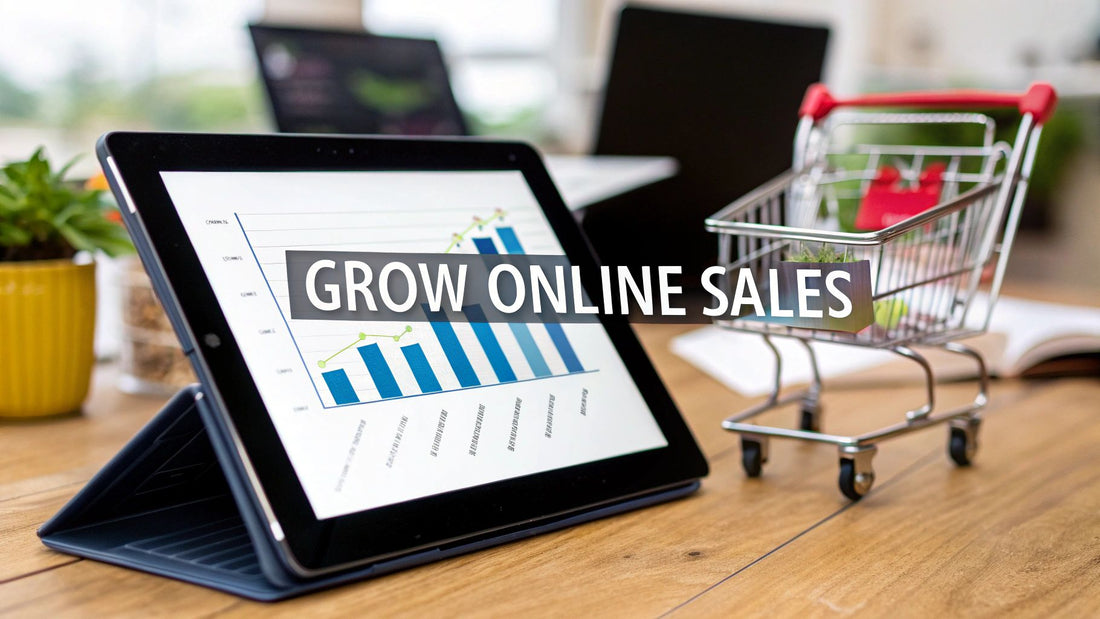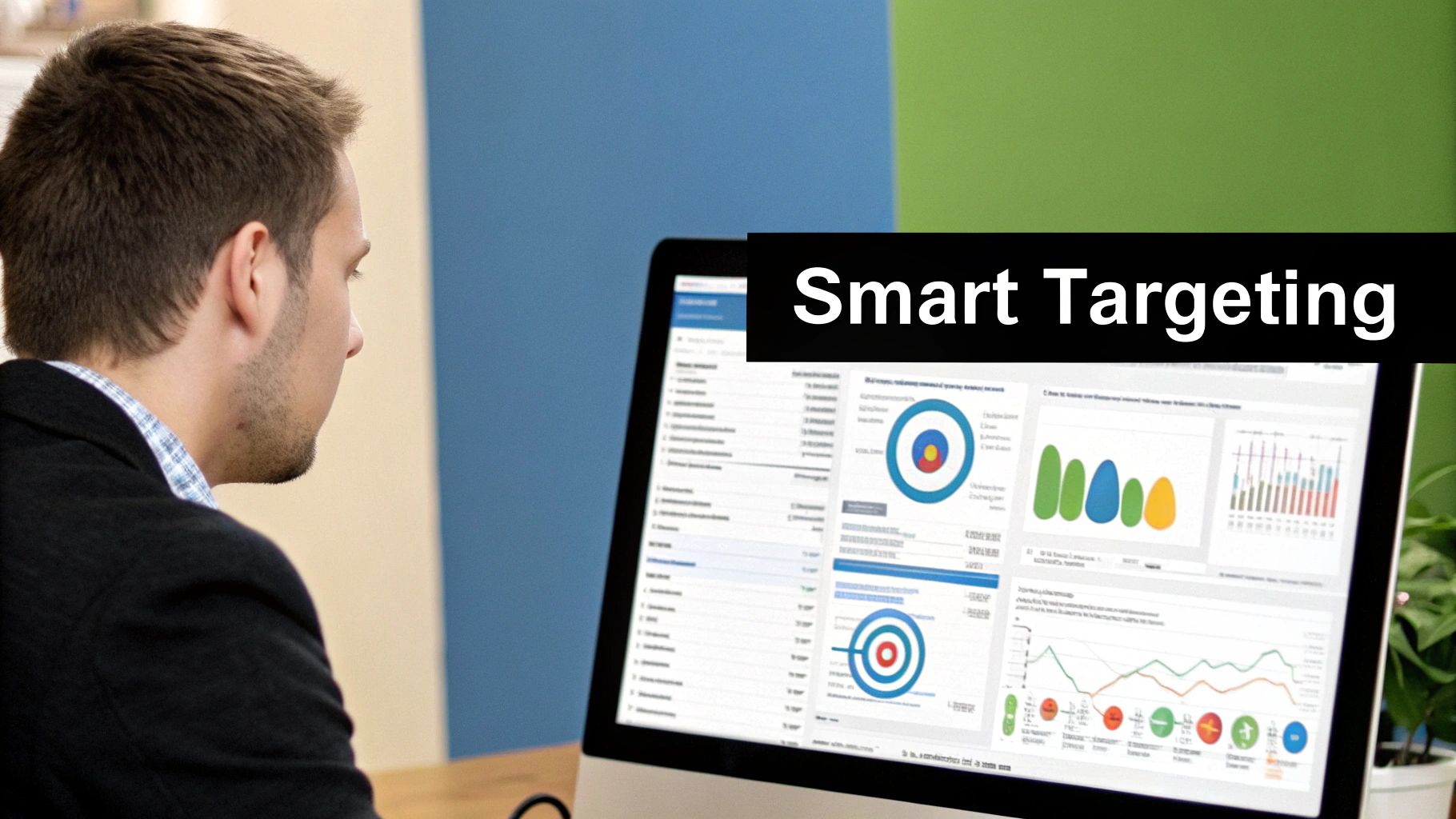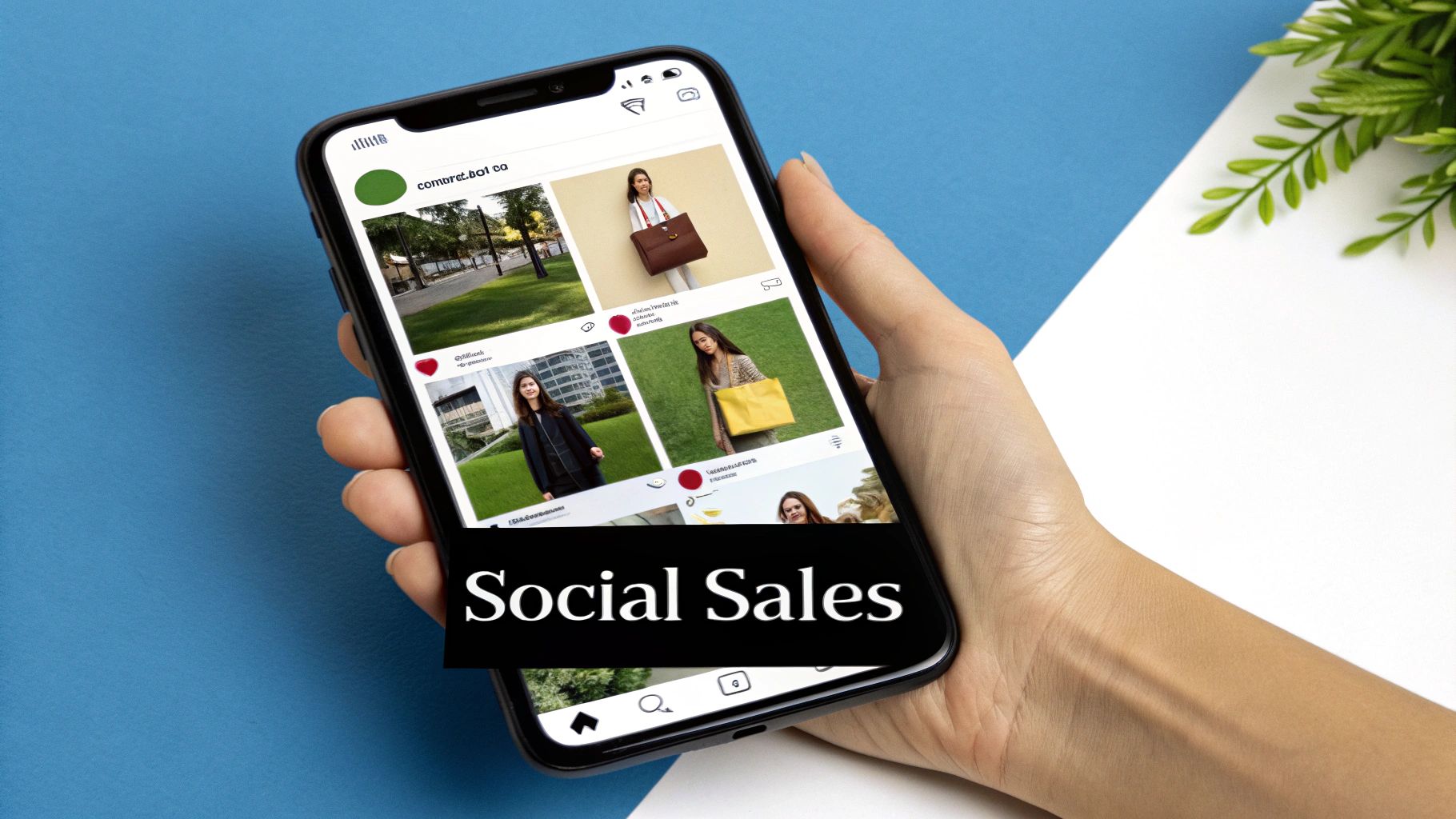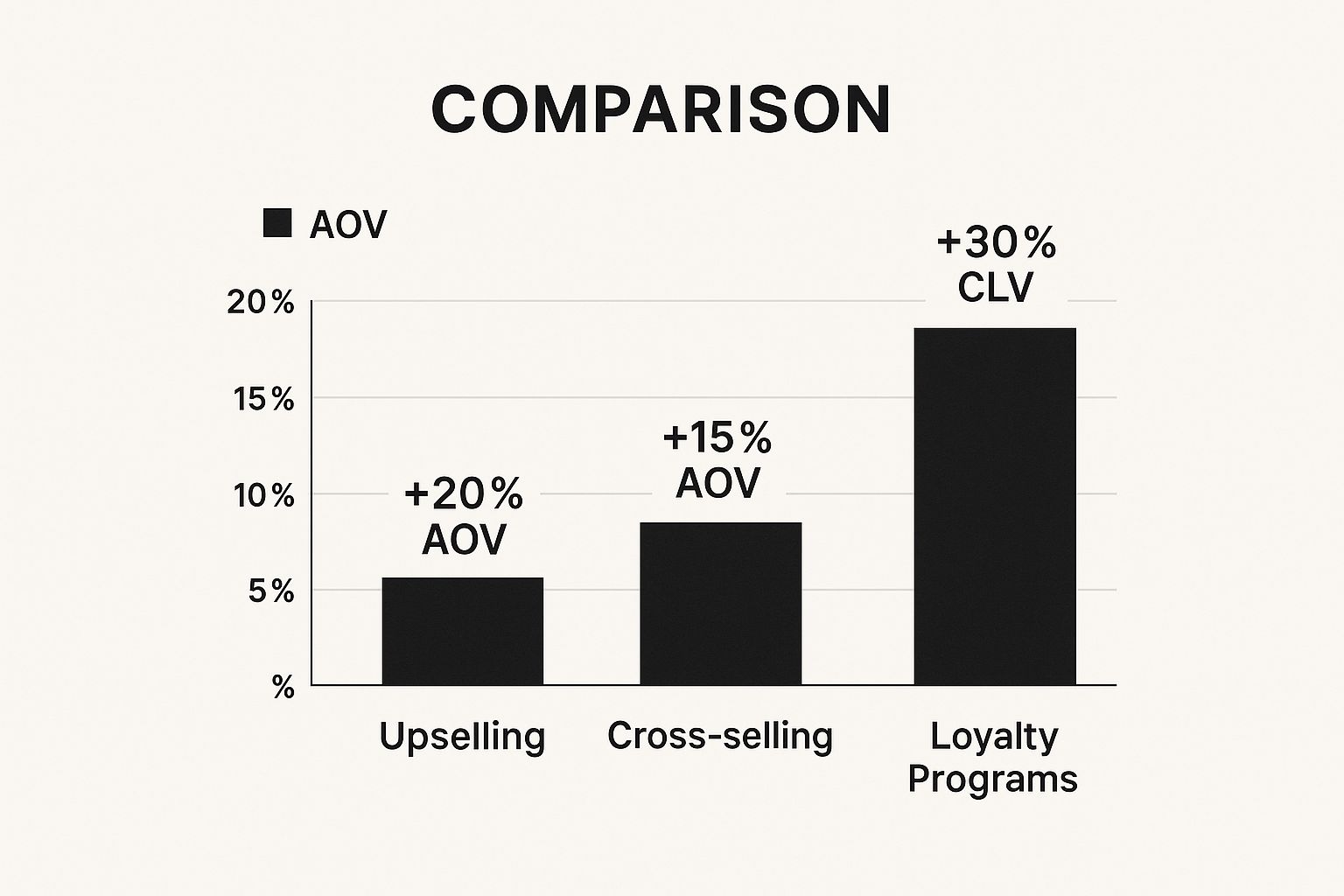
How to Increase Ecommerce Sales Proven Growth Strategies
Share
Growing your ecommerce sales isn't just about driving more traffic; it’s about making your digital storefront a place where people actually want to buy. It's a two-part puzzle: you need to attract the right people and then give them a seamless experience that guides them from browsing to buying.
Let's dive into how you can build that experience.
Build a High-Converting Customer Experience

Before you even think about spending a dime on ads, you have to get your own house in order. Driving traffic to a slow, confusing, or untrustworthy website is like pouring water into a leaky bucket—you're just wasting your money and effort. A truly exceptional user experience (UX) is the bedrock of any successful sales strategy, turning casual visitors into confident customers.
This isn’t just about making things look pretty. It's about function and trust. Every single element, from your navigation menu down to the checkout button, is either helping or hurting your ability to make a sale. A great customer experience removes friction, answers questions before they're even asked, and makes the path to purchase incredibly smooth.
Create Intuitive Site Navigation
Ever walked into a massive store with no signs or clear aisles? It's frustrating. That’s exactly what a poorly designed ecommerce site feels like to a new visitor. Your navigation has to be so intuitive that customers can find what they need with minimal effort.
Here’s how to get it right:
- Logical Categories: Group your products into simple, clear categories. If you sell clothes, use terms like "Tops," "Bottoms," and "Accessories" rather than overly clever brand jargon.
- Visible Search Bar: Make sure a search bar is front and center, preferably at the top of every single page. A lot of shoppers know exactly what they’re looking for and will go straight to search.
- Breadcrumb Trails: Use breadcrumbs (e.g., Home > Men's Apparel > T-Shirts) so people always know where they are. It lets them backtrack easily without getting lost or hitting the "back" button a dozen times.
A clean, predictable site structure keeps people engaged longer, which directly increases the odds they'll make a purchase.
Optimize for Lightning-Fast Page Speeds
In the world of ecommerce, speed is literally money. A mere one-second delay in page load time can slash your conversions by 7%. Shoppers today are incredibly impatient; if your site lags, they’ll just bounce over to a competitor.
Your website's performance is a direct reflection of your brand's professionalism. A fast, responsive site signals to customers that you are reliable and trustworthy, which is a crucial factor in their decision to buy.
The most common culprit for slow sites? Bloated images. Start by compressing all your product photos. From there, make sure you're using a reliable hosting provider and minimize any heavy plugins or scripts that are dragging down your site’s performance.
Design Product Pages That Sell
Think of your product pages as your digital salespeople. They need to be compelling, informative, and ultimately, persuasive. A great product page does more than just list features; it tells a story and helps the customer imagine how this product will fit into their life.
To make them effective, focus on these key elements:
- High-Quality Visuals: Use multiple high-resolution photos and, if possible, videos. Show the product from every angle, in different contexts, and being used by a person.
- Compelling Descriptions: Go beyond specs. Write clear, benefit-driven copy that answers the customer's main question: "How will this make my life better?"
- Social Proof: Don't hide your reviews! Prominently display customer ratings and testimonials. With over 90% of consumers reading reviews before buying, this is non-negotiable.
Improving your user experience doesn't have to be a massive, months-long project. There are several quick wins you can implement right now to see an immediate lift in sales.
High-Impact UX Improvements for Immediate Sales Lift
| Improvement Area | Actionable Tactic | Expected Impact on Sales |
|---|---|---|
| Page Speed | Compress all product images using a tool like TinyPNG and enable browser caching. | A 1-3% conversion rate increase for every second of improved load time. |
| Navigation | Add a prominent search bar to the header and implement breadcrumbs on product and category pages. | Reduces bounce rate and helps users find products faster, leading to more sales. |
| Product Pages | Ensure your "Add to Cart" button is a contrasting color and always visible "above the fold" on mobile. | Directly improves add-to-cart rates and simplifies the buying journey. |
| Trust Signals | Display security badges (like SSL certificates) and accepted payment logos (Visa, PayPal) in the site footer. | Increases customer confidence, reducing checkout abandonment. |
By focusing on these specific, high-impact areas, you can make your site work harder for you without a complete overhaul.
Prioritize a Flawless Mobile Experience
Mobile shopping isn't a "nice to have" anymore—it's everything. Experts project that mobile sales will hit an astounding $2.51 trillion in 2025, making up nearly 59% of all global ecommerce sales.
Consider this: 75% of ecommerce website visits are already happening on smartphones, according to industry research you can explore further on Backlinko.com. If your site is a pain to navigate on a phone, you are actively turning away the majority of your potential customers. A mobile-first design isn't just a good idea; it's essential for survival and growth.
Drive High-Intent Traffic with Smart Marketing

Look, a perfect website is great, but it's only half the story. To actually boost your sales, you have to get the right people to your store—shoppers who are already looking for what you sell. This isn't about just blasting your message to everyone. It's about precision. It's about capturing high-intent traffic from people who are ready to buy.
The best way to do this is with a smart, multi-channel approach. Think of it like a well-oiled machine where your organic search, paid ads, and content marketing all work together. When these pieces are in sync, you create a powerful engine that consistently delivers qualified buyers to your digital front door.
Capture Ready-to-Buy Shoppers with SEO
Search Engine Optimization, or SEO, is your secret weapon for attracting free, organic traffic. When someone types a question into Google, they are literally telling you what they need. Your job is simple: be the best answer they find.
The trick is to zero in on long-tail keywords. These are the longer, more detailed search phrases that signal someone isn’t just window shopping; they're deep into the buying process.
For example, a search for "running shoes" is incredibly broad. They're just looking around. But a search for "best trail running shoes for wide feet" tells you that person has a specific problem and is actively hunting for a solution. That’s a customer you can win.
- Optimize Your Product Pages: Weave these long-tail keywords into your product titles and descriptions. Don't forget the alt-text on your images, too—every little bit helps.
- Leverage Category Pages: Your category pages are SEO gold. Optimize them for slightly broader (but still specific) terms, like "women's waterproof hiking boots."
- Mind Your Technical Health: Make sure your site is technically sound. It needs to be fast, mobile-friendly, and secure (HTTPS). Search engines love this stuff and will reward you for it.
Bring Back Hesitant Shoppers with Paid Ads
Paid advertising on platforms like Google Ads and Meta gives you an incredible level of control to get in front of your ideal customer. While you can run broad campaigns to build awareness, the real money is made in retargeting.
Retargeting is all about reconnecting with people who have already shown interest. Maybe they visited your site, looked at a product, or even added something to their cart before getting distracted. These aren't cold leads; they’re warm. Sometimes all they need is a gentle nudge to come back and finish what they started.
A great retargeting ad doesn’t feel like an interruption; it feels like a helpful reminder. When you show a shopper the exact product they were just looking at, you reignite that initial interest and dramatically increase your odds of closing the sale.
Think about it: a customer was just checking out a pair of leather boots on your site. A few hours later, an ad for those exact boots pops up in their Instagram feed, maybe with a little sweetener like "Free Shipping Ends Tonight." It's personal, relevant, and incredibly effective.
Build Trust and Authority with Content Marketing
Content marketing is the glue that holds your entire strategy together. It’s how you build a real relationship with your customers that goes beyond a single purchase. Instead of constantly pushing for a sale, you provide genuine value. Over time, that value builds trust, and trust is what drives long-term, sustainable growth.
A solid content strategy should include a few key things:
- Genuinely Helpful Blog Posts: Write content that solves your customers' real-world problems. If you sell DTF transfers, a guide on "How to Choose the Right Heat Press Settings for Different Fabrics" is far more valuable than a simple sales pitch. It positions you as an expert.
- Engaging Video Content: Show, don't just tell. Create videos that show your products in action. Think tutorials, behind-the-scenes glimpses, or customer success stories. Video helps people visualize themselves using your product.
- A Powerful Email List: Your email list is your single most valuable marketing asset. Period. It's a direct line to your most loyal fans. Give people a compelling reason to sign up, like a 15% discount on their first order or early access to new products.
Once they’re on your list, treat them like VIPs. Send them valuable content, personalized product recommendations, and exclusive offers. Unlike social media, you own your email list. The algorithm can't take it away from you, giving you a reliable way to drive repeat business and build a loyal following.
Turn Social Media into a Sales Engine

Think of your social media profiles as more than just a place to post nice pictures. They're bustling, interactive storefronts where your most dedicated fans are already hanging out. The real trick to boosting your ecommerce sales is turning those passive scrollers into paying customers, and that means making it incredibly easy for them to buy.
This goes way beyond just showing off your products. It's about weaving your store right into the social platforms your customers use daily. When someone can discover and buy a product without ever leaving Instagram or TikTok, you’ve just knocked down the biggest barrier to a sale.
Make Your Feeds Shoppable
Let's be honest: the biggest killer of a potential sale is friction. Every extra click, every new tab they have to open, every second they spend searching your site for that one thing they saw on your feed—it’s a chance for them to get distracted and walk away. Social commerce bridges that gap by bringing the store directly to them.
Platforms like Instagram, Facebook, and TikTok have powerful shopping features that let you tag products right in your posts and videos. A user simply taps the tag, sees the price, and can head to checkout in moments. This isn't just a cool feature anymore; it's a core sales channel.
The numbers back this up. Global revenue from social media ecommerce jumped by 19.6% from 2023 to 2024, reaching an estimated $683.9 billion. That growth is happening because platforms are making it seamless for brands to sell where people are already engaged. You can dig into more of these trends on Capital One Shopping.
Build a Community, Not Just a Following
While shoppable posts are fantastic tools, they’re most effective when you have a genuine, engaged community behind them. People buy from brands they trust and feel a real connection with. Your social media goal should be to build that trust through real interaction, not just broadcasting sales pitches.
This is where you shift from just selling things to creating a true brand experience. Spark conversations, reply to comments, and make your followers feel like they’re part of something.
An engaged community is your most powerful marketing asset. They provide invaluable social proof, generate authentic content on your behalf, and become loyal advocates who drive sales far more effectively than any paid ad.
Here are a few practical ways to start building that community:
- Encourage User-Generated Content (UGC): Actively ask customers to share photos of themselves with your products. When they do, feature them! There is no social proof more authentic than a happy customer.
- Run Interactive Polls and Q&As: Use Instagram Stories or TikTok features to get your audience involved. Let them vote on a new t-shirt color or ask you anything about your brand. It makes them feel invested.
- Go Behind the Scenes: People love seeing the human side of a business. Share a video of your team packing orders or give a quick tour of your workshop. It makes your brand more relatable and trustworthy.
Collaborate with Authentic Influencers
Forget paying huge celebrities to hold up your product. The best influencer collaborations come from creators who genuinely love what you do and whose audience is a perfect match for yours. Zero in on micro-influencers—creators who may have smaller followings but boast incredible engagement. Their recommendations often land like advice from a trusted friend, not a sponsored post.
When looking for partners, pay more attention to their engagement rates than their follower count. A creator with 10,000 active, talkative followers is far more valuable than one with 100,000 who are completely silent.
For example, if you run a business that specializes in custom DTF transfers, teaming up with a popular t-shirt designer on YouTube is a perfect fit. Exploring a topic like DTF printing for shirts at https://cobradtf.com/blogs/guides/dtf-printing-shirt is something that provides real value to their audience and feels completely natural.
Increase Average Order and Lifetime Value
Let's be honest, constantly chasing new customers is exhausting and expensive. The real path to sustainable growth lies in getting more value from the customers you already have. This is where focusing on your Average Order Value (AOV) and Customer Lifetime Value (CLV) becomes a game-changer.
We need to shift our thinking from simply making a one-off sale to maximizing the potential of every single order and every customer relationship. It’s not about pushy sales tactics; it's about intuitively understanding what your customers need and presenting them with relevant, valuable options at just the right moment. Get this right, and you'll not only see revenue climb but also create a much better shopping experience.
This infographic breaks down how these different strategies can directly impact your most important metrics.

As you can see, a solid loyalty program is a long-term play that dramatically affects CLV, whereas upselling and cross-selling give you that immediate lift in AOV.
Master the Art of Upselling and Cross-Selling
Upselling and cross-selling are two of the quickest, most effective ways to boost your AOV on the spot. An upsell nudges a customer toward a more premium version of what they're already looking at. A cross-sell suggests complementary items that go with their purchase.
Imagine a customer adds a basic heat press to their cart. A smart upsell would be a pop-up showing a more advanced model with auto-open features for just a bit more. A perfect cross-sell would be to suggest Teflon sheets and heat-resistant tape—items they'll probably need anyway.
The key is to do this without being annoying. Here's how:
- Keep it Relevant: The recommendations have to make perfect sense. Suggesting something random just creates friction and noise.
- Showcase the Value: Don't just show another product; explain why the upsell is a better deal or how the cross-sell item makes the original purchase even better.
- Time it Right: The best time to make an offer is when a customer's intent to buy is at its peak—either on the product page itself or immediately after they add an item to their cart.
Smart recommendations feel like a helpful service, not a sales tactic. When you show a customer an accessory that will genuinely improve their experience with the product they're buying, you're building trust and increasing the order value at the same time.
Create Irresistible Product Bundles
Bundling is another fantastic way to drive up your AOV. By grouping several related products together at a slight discount, you offer incredible value and make the buying decision a no-brainer.
Think about creating a "DTF Printing Starter Kit." Instead of hoping a customer finds transfers, a heat pillow, and alignment tools separately, you bundle them. The customer gets everything they need in one click, and you just sold three products instead of one.
Tiered promotions are also incredibly effective. You could structure an offer like this:
- Spend $50, get free shipping.
- Spend $100, get free shipping + a 10% discount.
- Spend $150, get free shipping, a 15% discount, and a free sample pack.
This simple structure gives shoppers a powerful incentive to add just one more thing to their cart to hit that next reward tier, directly bumping up your AOV.
Foster Loyalty for Long-Term Growth
While AOV tactics give you that instant gratification, building Customer Lifetime Value is the long game that creates real, lasting stability for your business. A loyal customer will spend more with you over their lifetime and is far cheaper to keep than it is to find a new one.
A well-thought-out loyalty program is your best tool for encouraging repeat business. It doesn’t have to be overly complex. You could offer points for every dollar spent that customers can redeem for discounts or exclusive products. This approach gamifies the experience and gives them a very compelling reason to come back to you instead of a competitor.
Building that kind of relationship is critical. For a deeper dive, our guide on how to build customer loyalty lays out more detailed strategies you can use. Remember, these programs are about more than just points and discounts; they're about making your customers feel seen, valued, and part of your brand's community.
AOV vs. CLV Strategy Comparison
Deciding where to focus your efforts—on immediate wins or long-term gains—is a key strategic choice. The table below breaks down the differences between tactics designed to boost AOV versus those aimed at nurturing CLV.
| Strategy | Primary Goal | Example Tactic | Implementation Effort |
|---|---|---|---|
| Upselling | Increase the value of the current transaction | Suggesting a premium version of a product | Low to Medium |
| Bundling | Increase items per order and perceived value | "Starter Kit" with multiple related items | Medium |
| Cross-selling | Add relevant, complementary items to the cart | "Frequently Bought Together" recommendations | Low to Medium |
| Loyalty Program | Encourage repeat purchases and build relationships | Points-based rewards system for future discounts | Medium to High |
| Email Marketing | Nurture leads and drive repeat traffic | Personalized follow-up campaigns and newsletters | Medium |
| Tiered Discounts | Incentivize customers to spend more per order | "Spend $100, get 15% off" | Low |
Ultimately, a balanced approach is best. Use AOV-boosting tactics to maximize revenue from each sale, but never lose sight of the CLV strategies that build the loyal customer base you need for sustainable, long-term success.
Scale Your Operations for Sustainable Growth
So, your marketing is working and the sales are rolling in. That’s fantastic, but now you’re facing a new set of challenges that can either cement your success or sink your business entirely. Can your backend operations actually handle the volume?
If you’re not prepared, you'll run into shipping delays, frustrating stockouts, and unhappy customers. All that hard-won brand loyalty can evaporate in an instant. Smooth, efficient operations are the unsung hero of any great ecommerce store, turning a promising shop into a brand that can actually scale.
Master Your Inventory Management
There's no bigger sales killer than a "Sold Out" button on your hottest item. Good inventory management isn't just about counting what you have on the shelf; it's about seeing the future. You need to know what customers will want and have it ready for them, without tying up all your cash in products that aren't moving.
Getting a grip on this usually starts with a solid inventory management system. This gives you a live, real-time look at your stock levels everywhere you sell.
- Set Reorder Points: Don't wait until you're completely out. Set an automatic alert to notify you when stock for a specific product hits a minimum level, giving you plenty of lead time to reorder.
- Use Forecasting: Look at your past sales data. Are there seasonal spikes? Does a certain marketing campaign always cause a run on a particular item? Use that history to predict future demand.
- Implement FIFO: This stands for First-In, First-Out. It's a simple system to ensure you sell your oldest stock first, which is an absolute must to avoid products becoming obsolete or expiring.
Getting your stock management right is a non-negotiable skill. For a deeper dive, our complete guide on inventory management best practices will help you dial in your strategy.
Streamline Your Fulfillment Process
The moment a customer clicks "Buy Now," a timer starts. Their excitement is at its peak, but it can quickly sour if their order seems to disappear into a black hole. Your fulfillment process—everything from picking the item off the shelf to packing it and getting it on a truck—has to be a well-oiled machine.
Look for bottlenecks. Could you rearrange your warehouse to create a more logical picking route? Can you group similar orders together for batch processing? Every minute saved gets the product into your customer's hands faster.
A fast and accurate fulfillment process is one of the most powerful loyalty builders you have. When a customer receives their order quickly and in perfect condition, it reinforces their decision to trust you with their money.
And don't forget about the box itself. Packaging is the first physical touchpoint a customer has with your brand. Think about it—branded tape, a handwritten thank-you note, or a small free sample can transform a simple delivery into a memorable unboxing experience worth sharing.
Prepare to Tap into New Markets
Thinking beyond your home turf is where real, long-term growth happens. The global ecommerce market is enormous and getting bigger every day, creating huge opportunities for businesses ready to sell internationally.
The numbers are staggering: global ecommerce sales are on track to hit $6.42 trillion worldwide in 2025. Most of that growth is coming from major players like China, the United States, and Western Europe, which are expected to account for over $5.17 trillion of those sales. You can get more insights on this from Shopify's global sales analysis. Breaking into these cross-border markets is a direct line to explosive growth.
But going global means you have to get a few things right:
- International Shipping: Find reliable carriers that offer international tracking. Nobody likes uncertainty, so be completely transparent about shipping times and costs right from the start.
- Payments and Currencies: Your payment gateway needs to handle multiple currencies and the payment methods popular in other countries. Simply showing prices in a customer's local currency can make a huge difference in your conversion rates.
- Duties and Taxes: Be clear about who pays for customs fees. Some fulfillment partners can even help you calculate and collect these duties at checkout, which makes for a much smoother delivery for your international customers.
Got Questions About Growing Your Ecommerce Sales? We've Got Answers.
Jumping into the world of ecommerce can feel like you're trying to drink from a firehose. There are a million different strategies, a dozen marketing channels, and everyone has an opinion. It’s natural to have questions.
Let's cut through the noise and tackle some of the most common questions we hear from store owners.
Where Should I Even Start With Marketing?
The sheer number of marketing options out there is enough to make anyone’s head spin. The biggest mistake I see new store owners make is trying to do everything at once. You end up spreading yourself too thin and mastering nothing.
Instead, zero in on one or two channels where your customers actually spend their time.
For most online stores, the one-two punch of SEO and email marketing is a killer starting point.
- SEO is the long game. It’s about attracting people who are literally typing what you sell into a search bar. It might take time, but this builds a reliable stream of free, high-intent traffic that you don't have to pay for with every click.
- Email marketing is your direct line. Unlike social media, you’re not at the mercy of some mysterious algorithm. You own your list, and it's the single best way to build relationships, announce products, and drive repeat business.
Once you have a handle on these two, then you can start experimenting with things like paid social ads or a deeper content marketing strategy. Get one thing working well before adding another.
Seriously, How Much Should I Be Spending on Marketing?
There’s no magic number, and anyone who gives you one is guessing. Your marketing budget really depends on your industry, profit margins, and where you are in your business journey.
That said, a good rule of thumb for ecommerce brands is to earmark somewhere between 5% and 15% of your total revenue for marketing.
A brand new store fighting for its first customers? You’ll probably need to be closer to that 15% mark just to get your name out there. A well-known brand with a ton of repeat buyers might cruise along comfortably at 5-8%.
The most important shift in mindset is to stop seeing marketing as an expense and start treating it as an investment. Keep a close eye on your Return on Ad Spend (ROAS) for paid ads and your overall Customer Acquisition Cost (CAC). This data doesn't lie—it will tell you exactly where to put your next dollar for the best return.
How Do I Know if Any of This Is Actually Working?
Gut feelings don't grow a business. The only way to know if your strategies are paying off is to measure them. You need to get friendly with the numbers that tell the true story of your store's health.
Don't get overwhelmed by data. Just start by tracking these essentials:
- Conversion Rate: Out of every 100 visitors, how many actually buy something? This is the ultimate test of your website's effectiveness.
- Average Order Value (AOV): What's the typical ticket price for an order? Bumping this number up is one of the quickest ways to increase revenue without needing more traffic.
- Customer Lifetime Value (CLV): How much is a customer worth to you over their entire relationship with your brand? This metric shows you if you're building real loyalty or just a one-and-done transaction business.
- Cart Abandonment Rate: How many people add products to their cart but bail before paying? A high number here is a massive red flag that something is broken in your checkout process.
You can set up a basic dashboard in Google Analytics for free to watch these numbers every week. When you see a number change—for better or worse—you can investigate why. This is how you make smart, data-backed decisions instead of just guessing.
At Cobra DTF, we provide the high-quality, USA-made DTF transfers you need to create stunning products that keep customers coming back. Boost your quality and cut down on shipping times with our reliable, vibrant transfers.
